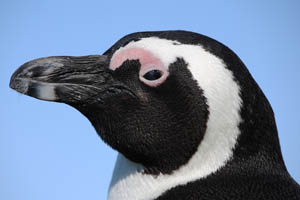
African (Jackass) Penguin |
 |
Specific Name: Spheniscus demersus | ||
|
|
|||
| Adult Height: 68cm | |||
| Adult Weight: 3-3.6kg | |||
| Adult Flipper Length: 15-18cm | |||
| Estimated Population: 150000 |
Feeding: |
||||||||||
Preferred prey species are cape anchovies and other shoaling pelagic fish such as sardines or mackerel. Squid and small crustaceans may also be eaten. Sardines and anchovies made up between 50 and 96% of prey in various studies. In 1989 and 1991, the diet of Robben Island Penguins constituted 95% anchovies. In 1990 and 1992, when anchovy numbers were lower (72, 68% of diet, respectively), sardine (12%) and horse mackerel (22%) respectively, served as the primary fallback prey species (Crawford and Dyer, Ibis 137, p.329-339 (1994)).Numerous studies have addressed diet and impact of food availability on breeding success. At Robben Island, a clear correlation between prey biomass and breeding success (chicks reared annually) could be established (Crawford et al., Biological Conservation 132, p.119-125 (2006)). When the combined spawner biomass of anchovies and sardines of South Africa was over 2 million tonnes, a mean of 0.73 chicks/pair were reared annually. When below this level, only 0.46 chicks per year were reared. This shows the importance of fisheries management on penguin numbers. Levels of prey naturally fluctuate, yet the overall numbers and extent of fluctuation are negatively influenced by commercial fisheries.The hunting range of African Penguins can be studied using GPS loggers, including pressure sensors, which are attached to birds whilst they are on land between foraging trips. Studies on birds with young chicks at the Boulders Beach, Robben Island and Dassen Island colonies (Ryan et al., Marine Biol., 145, p.215-223 (2004); Petersen et al., Ibis 148, p. 14-26 (2006)) revealed that birds from Boulders swim in a more or less straight line between the colony and the foraging area in the center of False Bay, making the occasional searching dive looking for prey. During this commuting phase, an average speed of 1.2 m/sec was measured with birds reaching a maximum speed of just under 3 m/sec usually when approaching or leaving the colony. When prey has been located, foraging starts and the routes swum become more sinuous. For birds living on Robben Island, the straight commuting phase is not evident since foraging appears to be possible close to shore. During the foraging phase, birds dive an average of 33 times per hour, to a mean depth of 17 m and a maximum of 69 m. Surface displacement of birds averages about 0.93 m/sec during this phase. Dive length may exceed 2 minutes, although averages about 50 secs. Birds may also spend periods resting at sea, particularly at night when diving activity is minimal due to the requirement of light for hunting. During these rest phases birds generally simply drift although marginally more movement is recorded during daytime rest phases.Interestingly, birds from Boulders spent longer at sea and travelled further than birds from the Island-based colonies. In both cases, birds on 1-day foraging trips tended to head to sea before sunrise (mean times: Boulders 5:10, Islands 6:44). Birds returned in the evening to feed their chicks, arriving at mean times of 18:10 and 16:56 to Boulders and Island colonies, respectively. The foraging distance had a mean of 46 km for birds from Boulders, but only 33 km for Island-based birds and involved a mean range from the colonies of 18.5 and 9.5 km, respectively. Birds may also go on multiday foraging trips covering distances of well over 100 km, especially when chicks are older or when food is scarce. Non-breeding birds may stay at sea for long periods of time.African Penguins tend to go foraging in groups. When in small groups, birds dive and surface in a somewhat coordinated manner. Less coordination is visible when larger groups of penguins are foraging at one site. Hunting is, however, not cooperative in the sense that one bird acts for the benefit of others. In the afternoon, birds returning to shore can often be observed in groups ("rafts") off the coast. As they near the beach they accelerate, making a short 100-200 m dash for shore which involves shallow travelling dives punctuated by porpoising. This behaviour is presumably to avoid predators such as seals which are found near the coastline.
|
Reproduction: |
||||||||||||||||||||||||||||||
Breeding activity occurs throughout the year with peak activity being observed from March to May in S. Africa and in November / December in Namibia. This presumably results from different patterns of food availability at the different sites. In the following explanation, penguins in the Cape Town area breeding at the peak time are taken as an example.Adult birds typically fatten up at sea for 5-6 weeks prior to their annual moult in November to January, during which they lose about half of their body weight. The moulting process takes about 20 days. Once completed, birds return to the sea to feed intensively for about 6 weeks to regain weight in preparation for breeding. Penguins usually assemble at the nesting site in February when they either look for a mate (first breeders) or reestablish the pair bond with their regular partner. African Penguins are essentially monogamous (over 80% breed with the same partner as the previous year) and do not tend to change partners unless forced to by death or absence of the partner from the breeding site.Courtship or reinforcement of the pair bond generally involves a number of characteristic forms of behaviour. Ecstatic displays, high frequency clattering of beaks against each other, allopreening or circling around each other with heads bowed can all be observed. Eventually, penguins repeatedly copulate in order to achieve fertilization of the eggs. The copulation procedure also involves some interesting behaviour. Immediately preceding copulation, the male bird may approach the upright female from behind and clap her frantically on both sides with his flippers to signal his readiness. When the female bird is lying down the male may approach her in a crouched manner from the front and beak-clattering may occur. The male then gradually edges his hind around the female whilst maintaining heads in close proximity, eventually trying to climb onto the back of its partner to bring the to cloaca into proximity. During copulation, birds may make regular beak contact and the male tends to wriggle his hind end around a little, possibly to assist sperm transfer.
Two eggs are laid and incubated for about 40 days, the hatching of one egg usually preceding the other by up to 2 days. Parents alternate in incubation duties with the other staying out at sea for the day or sometimes up to 3 days at a time if food is scarce. Many eggs fail to hatch at all, and often if they do only one chick will survive to adulthood. Chicks are brooded for about 30 days, initially to help them keep warm, later only to protect against predation by (e.g.) Kelp gulls which hang around colonies looking for opportunities to grab eggs or small chicks. Partners again alternate in their brooding and foraging duties and switch roles more frequently than during egg incubation. After about 30 days, both parents go to sea to gather food and the chicks are left at the colony where they may form small creches. The chicks initially have a thin protoptile down which has poor insulation properties and allows bodily warmth from the parents brood patch to be transferred to the chick. After about 2 weeks, this down thickens, forming the mesoptile down which is insulating and allows the chick to maintain its own body temperature. This thicker down carries with it the disadvantage that during hot spells the chicks may suffer fatal heat stress. The fluffy down is replaced by the blueish juvenile plumage after 60-130 days, depending on food availability. This plumage lacks the characteristic banding of the adult birds. Once the juvenile plumage is complete, the juveniles can in principle fledge. The final trigger for fledging is probably abandonment of the chicks by the parent. Once provisioning is stopped, the chicks need to go to sea to find their own food. At this point, there is no further parental support at all, and juvenile birds need to teach themselves foraging and predator avoidance. This is possibly one reason for the high mortality seen in juveniles.
Juveniles usually stay away from the colony for well over a year (and may indeed never return to the colony they originated from) before moulting on land into their adult plumage. This so-called immature moult can take place anything from 12-23 (average 15.4) months after hatching and is centered around mid-summer at all breeding sites (Kemper and Roux, Ibis 147, p.346-352, (2005)). This wide range can be explained by the fact that whilst chicks fledge throughout the year, the main moult period is more constrained, taking place from Nov. to January. Birds that fledge during summer and early autumn tend to squeeze in their moult in the next summer moult season ("squeezers"), whereas birds fledging in late autumn, winter or spring tend to skip the next moulting season ("skippers"). "Skippers" that have to wait a long time to moult may develop problems due to plumage wear, which may eventually lead to loss of waterproofing. This is especially a problem for autumn-fledging birds which have the longest wait until moulting. Loss of waterproofing before the moulting period will inhibit feeding and ultimately result in starvation. Some juveniles may develop adult head plumage patterns by a partial immature moult. This occurs at sea and thus has a high energy cost. Consequently it is thought that only the strongest birds can do this. Such a moult is considered as a sign of social status and reduces aggression from adults, often allowing acceptance into adult feeding groups (Ryan et al., Behav. Ecol. Sociobiol. 20, p.69-76 (1987)). These birds will then proceed to moult fully at a later stage.Generally, young penguins are hardly distinguishable from other adult birds after the immature moult. They can be sexually mature in as little as 2 years although they rarely actually start breeding until reaching the age of 3-4.African penguins may reach ages of up to at least 27 years in the wild, although only less than 1% appear to reach 20, based on records of banded birds (Whittington et al., Marine Ornithology 28, p.81-82 (2005)). A 22 year old penguin has been recorded with chicks.
|
General Behaviour: |
||||||||||||
The most notable aspect of African Penguin behaviour is the loud donkey-like braying noise emitted during the ecstatic display. This noise, common to other penguins of the Spheniscus genus, earned them their previous name "Jackass Penguin". The display is used as a courtship ritual but also to reinforce pair bonds. This is why following a partners return from sea, penguin pairs can often be seen performing the display. An incubating parent may perform a lying down version of the display as opposed to the regular upright one and the arriving partner may perform a stooped version facing the incubating bird.Allopreening (preening each other) can commonly be observed in African penguins. Penguins can not easily preen their own heads and necks, and if on their own need to use their feet to do so. Allopreening is thus highly practical for cleaning and rearranging their feathers or for removing parasites such as ticks. Further, it has a social element and serves to reinforce the pair bond.
African penguins can often be observed bathing within a few meters of the shore, shaking their bodies around wildly and preening themselves with beak and feet. This serves to clean their plumage. On hot days, penguins may enter the water occasionally to cool themselves. Interestingly, the brood patch may be open when birds are bathing near shore (personal observation), whilst the patch generally is covered in feathers when birds are foraging since they would otherwise suffer from hypothermia.
Fighting is occasionally observed and involves beating with flippers and more often biting. Penguins can occasionally be observed wildly chasing through colonies clutching an adversaries back or neck with their beak whilst beating it with their flippers.If birds are disturbed they may become less active or they may lean towards the intruder with neck somewhat outstretched, often tipping their head from side to side as they do so. If visitors to a colony encounter this behaviour they are probably too close to the penguins. |
Threats: |
||||
The major decline in African penguin numbers in the 20th century can be initially attributed to harvesting of eggs for food (outlawed in 1967) and guano for the fertilizer industry. Like the Humboldt penguin, the African penguin relied heavily on burrows excavated in the meter thick guano deposits, formerly found at many nesting sites, to protect eggs and young from predators and direct sunlight. The guano is particularly important when penguins nest in sparsely vegetated rocky areas where little other protection may be found. Chick mortality can be high during periods of hot weather since the chicks do not have the option of cooling themselves in the sea until they have moulted for the first time and obtained waterproof feathering. Numerous chicks apparently died at Foxy Beach (Boulders) in 2008 as a result of prolonged direct exposure to intense sunlight and high temperatures. This affected progeny of penguins nesting in the open on the beach rather than those in the dense vegetation behind.Today, the population density of African Penguins is largely regulated by prey availability. Competition for food by commercial fisheries is also thought to have contributed to the decline in numbers. This is discussed in the section on Feeding above. When food levels are critically low, penguins may either not start to breed, or, after breeding has started, foraging trips may be so long that penguins abandon their nests before the foraging partner returns. Mass abandonment of nests was observed at Dyer island in 1991 and is attributed to food shortage (Crawford and Dyer, Ibis 137, p.329-339 (1994))Pollution, in particular oil spillages, poses a major threat to African Penguins as to other seabirds. Even small spillages can cause the oiling of many birds, possibly due to the fact that fish may be found concentrated under oil slicks, thus drawing predators such as penguins to the affected areas (Kerley et al., 1987. S. Afr. J. Wildlife Res. 17(4), p.128-130). Oil causes feathers to clump together and allows water to seep in between, thus exposing the birds to the elements. Further, affected birds tend to ingest oil as they preen their oiled plumages. Ingestion of oil leads to petrochemical poisoning which may manifest itself by internal ulceration or loss of sight. Several major oil spills have affected the African Penguin populations. In 1968, about 3000 penguins were oiled following the grounding of the Esso Essien, and in 1994, about 10000 penguins were oiled after the sinking of the Apollo Sea (Underhill et al., 1999. Ibis 141(1), p.29-37).The worst incident so far occurred on June 23, 2000, when the bulk ore carrier MV Treasure sank between Dassen and Robben Islands, which host the 1st and 3rd largest breeding colonies of African Penguins, respectively. 1300 tonnes of bunker oil were spilled, leading to the oiling of 19000 penguins, mainly on Robben Island. This triggered the biggest bird rescue operation in history, coordinated by SANCCOB (S. African Foundation for the Conservation of Coastal Birds), IFAW (International Fund for Animal Welfare) and IBRRC (International Bird Rescue Research Center). The oiled birds were collected and transferred mostly to a rehabilitation facility hastily set up in an old railway yard in the Salt River area of Cape Town. Over 90% of these birds could be released after they had been stabilized, cleaned and gradually rehabilitated over a period of several months. A further unoiled 20000 penguins were evacuated by helicopter or fishing boats from Dassen Island, which was in the projected path of the oil slick, and transported overland to the Port Elizabeth area, where they were released. Several of these birds were tracked using transmitters, and were found to swim straight back towards their home colonies (Barham et al., 2006. Ostrich 77(3/4), p.202-209)). However, in the 2 weeks it took them to do so it was possible to clean up much of the oil. The African Penguins in the Cape Town area today are a living tribute to the many staff and volunteers who assisted in the rescue effort. A detailed report on the penguin rescue efforts following the Treasure oil spill can be found on the IBRRC website. Even in years with no major oil spills, many oiled penguins are found. For example, in 2001 and 2002 a total of 991 oiled penguins were admitted to the SANCCOB rehabilitation center (Parsons and Underhill, African. J. of Marine Sci., 27(1), p.289-296 (2005)). Most of these admissions were in winter when the prevailing winds blow oil (often illegally washed from ships bilge tanks) near to the shore. Fortunately, over 85% of these birds could be released.Knowledge on survival and subsequent breeding success of rehabilitated oiled birds is of major importance for conservation purposes, so that resources can be optimally channelled when the next major incident is encountered. It has been found that breeding pairs including at least one oiled bird rehabilitated after the Treasure oil spill have an about 30% reduced breeding success, in terms of numbers of fledged chicks compared to unoiled birds (Barham et al., 2007. Emu 107, p.7-13). Whilst hatching success was similar and also survival of chicks during the brood / guard phase, mortality of chicks was about 4-fold higher in the creche phase. This is likely because this phase is most demanding on the parents, as it involves the highest food demand by the chicks. Those chicks that survived also took longer to fledge. The reasons for these observations are unclear, although likely a result of the prolonged captivity and / or delay in washing after capture (due to the vast numbers of oiled birds), possibly resulting in higher oil uptake. Lengthy capture may also result in increased disruption of pair bonds. This could reduce breeding success, since pairs that repeatedly breed tend to be more productive. A previous study on birds oiled following the Apollo Sea spill had not found a reduced reproductive success, yet the two spills and ensuing rescue efforts were not entirely comparable, since birds were processed quicker and the oil was of a different type in the latter case (Wolfaardt and Nel 2003. In "Rehab. of Oiled Afr. Penguins". Eds. Nel and Whittington. p.18-24).Following the Treasure oil spill, large numbers (about 2000) of orphaned chicks were also collected and subsequently hand-reared. The subsequent breeding success of these chicks has been monitored (Barham et al., 2008. Bird Cons. Intl. 18, p.144-152). Surprisingly, the eventual breeding success of hand-reared chicks was found to be at least as good as that of naturally reared chicks. This not only shows that hand-rearing is a worthwhile conservation effort, but also suggests that hand-reared chicks, possibly from captive populations, could be used to bolster the wild populations if necessary.Predation may also have a major impact on colonies, either due to the introduction of unnatural predators such as cats or dogs, or due to increases in natural predator numbers as a result of decimation of their natural enemies. This is particularly the case for Cape Fur Seals, numbers of which have increased due to the mainly human-induced decline in Great White Shark numbers. Fur Seals can be observed waiting just offshore in front of penguin colonies and may take penguins leaving or returning to sea. In April 2008, I observed one Fur Seal taking two penguins within 30 min as they returned to Foxy Beach (Boulders) after feeding. The loss of a parent will usually also result in the loss of the chicks. Studies at Dyer Island in 1995-1996 revealed that Seals killed 8.7% of the Penguin population in a single year (Marks et al., Marine Ornithology 25, p.9-12 (1997)). In such cases, culling of the predator is essential to sustain the penguin population.
At sea, not only Fur Seals are a threat, but also certain sharks and Orcas, although the numbers of these have been declining in recent years. On land, Kelp Gulls and Sacred Ibises as well as Mongooses steal eggs and young chicks from nests.
Plasmodium relictum (an avian malaria parasite) is the main blood parasite that can be detected in African Penguins. Birds with obvious malaria symptoms are not generally seen in the wild, although these may often be removed by predation or death at sea. However, studies on birds admitted to the SANCCOB rehabilitation center reveal a high level of exposure of birds in the Western Cape region to the parasite with over 30% of admitted birds being seropositive upon admission in certain years (Parsons and Underhill, African. J. of Marine Sci., 27(1), p.289-296 (2005)). Malaria primarily affects juvenile birds during the summer months. As in humans, the first exposure to the parasite is the most critical as no resistance has been developed yet. Mortality in captive birds can be high, presumably due to the higher stress that these birds are subjected to resulting in a weaker immune system. In fact, avian malaria is the most common cause of death of captive penguins in open-air colonies (Graczyk et al., J. Parasitology 80(2), p.302-308 (1994)). The extent to which wild-living birds are affected by infection is not known, although it would seem likely that even subclinical infection has a slight impact on the bird's overall health. Avian cholera may also sporadically affect penguin populations.Loss of habitat to humans is a lesser problem since most island colonies are not inhabited by man. Human populations can in fact provide a buffer zone against terrestrial predators thus allowing establishment of mainland colonies as at Boulder Beach. African penguins are highly adaptable and will nest in gardens, under verandas or in drainage systems. The downside of nesting in suburbia is that penguins may be lost in road traffic accidents or may fall victim to uncontrolled or escaped pets. Nest disturbance is also more likely. |
Where To See: |
||||||||||||||
Whilst most colonies of African penguins are on inaccessible small islands, several easily accessible colonies exist. The primary viewing site is the colony at False Bay (Boulders) in Simons Town, just south of Cape Town. The colony was established by 2 breeding pairs in 1982 and has since grown to a population of over 2000. Boulders Beach Lodge provides a perfect base for exploring this colony which is spread along a number of small bays and in the vegetation behind them. The only beach on which penguins nest openly is Foxy Beach. This beach can no longer be accessed, but viewing is possible from 2 wooden walkways. Small numbers of nesting penguins may also be observed just south of the lodge. Boulders, 1st and Middle Beaches provide good venues for observing penguins coming in or out of the sea or preening themselves in shallow water.Another good site is found at Stony Point, Betty's Bay, about an hours drive to the south of Cape Town. Visitors can get good views of the colony from boardwalks, much like at Boulders, although the colony is significantly smaller.A further colony that can be visited is the larger colony at Robben Island which is accessible by boat from Cape Town. However, the colony can only be briefly visited as part of a guided tour of the island. African Penguins can also be observed on Dyer Island. This is however only possible from boats, which usually near the Island during trips to view the Great White Shark. These trips depart from Gaansbaai.
Please note that whilst penguins at Boulders beach are relatively used to human interaction, visitors should try and keep a reasonable distance and not make rapid movements or loud noises in their presence. A penguin that is running away should not be followed. Any disturbance will increase the heart rate of the penguin and consequently its energy usage.The Boulders Beach colony is the subject of the multi-award-winning documentary "Penguin City Slickers", directed and filmed by Trevor de Kock . This sometimes light-hearted documentary not only focuses on the interaction of the penguins with the inhabitants of Simons Town, but also documents the tragedy of the Treasure oil spill and the resulting rescue effort.
|
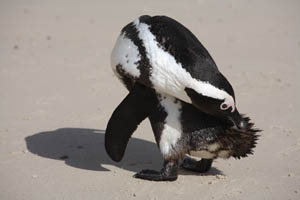 |
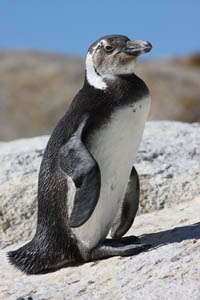 |
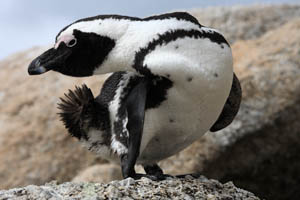 |
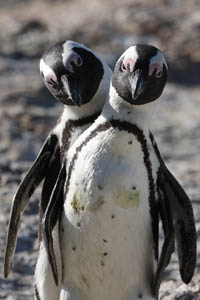 |
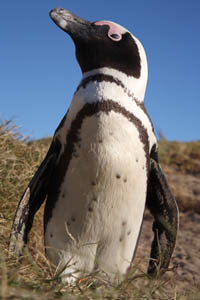 |
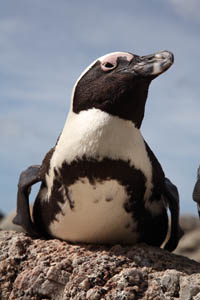 |
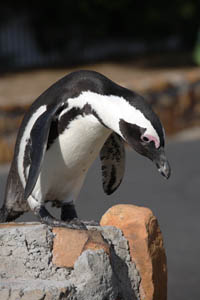 |
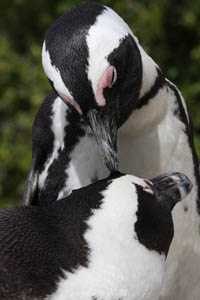 |
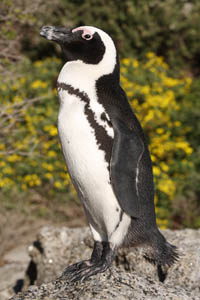 |
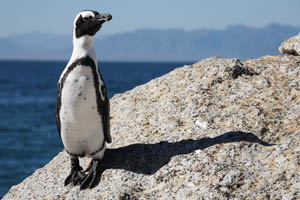 |
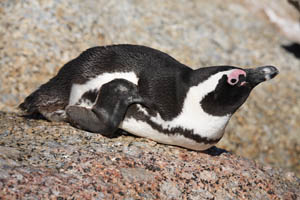 |
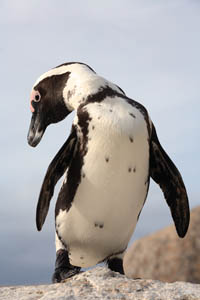 |
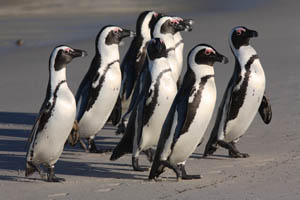 |
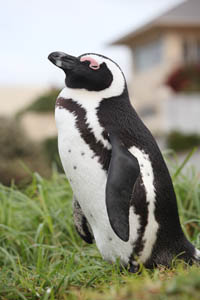 |
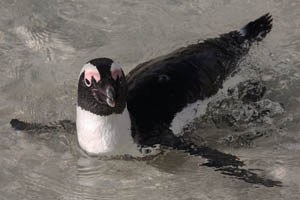 |
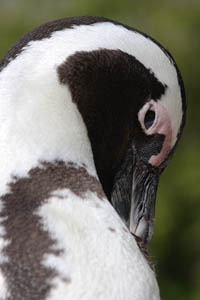 |
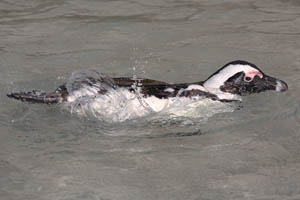 |
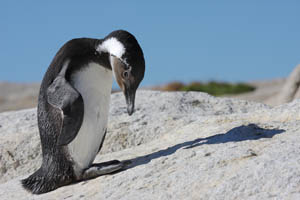 |
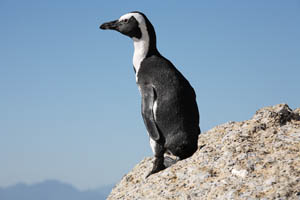 |